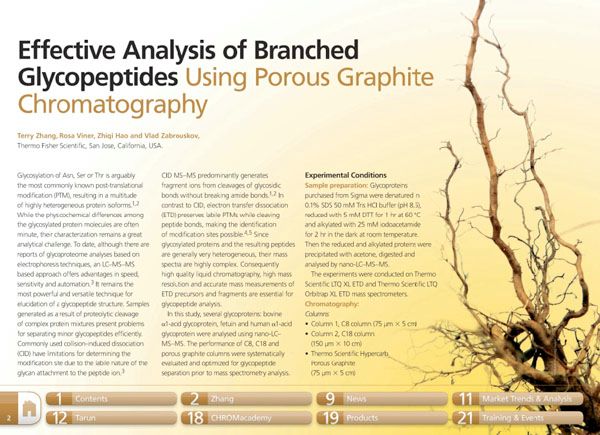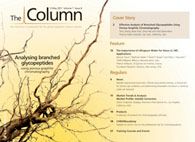Effective Analysis of Branched Glycopeptides Using Porous Graphite Chromatography
Effective analysis of branched glycopeptides using porous graphite chromatography
Glycosylation of Asn, Ser or Thr is arguably the most commonly known post-translational modification (PTM), resulting in a multitude of highly heterogeneous protein isoforms. While the physicochemical differences among the glycosylated protein molecules are often minute, their characterization remains a great analytical challenge. To date, although there are reports of glycoproteome analyses based on electrophoresis techniques, an LC–MS–MS based approach offers advantages in speed, sensitivity and automation.3 It remains the most powerful and versatile technique for elucidation of a glycopeptide structure. Samples generated as a result of proteolytic cleavage of complex protein mixtures present problems for separating minor glycopeptides efficiently. Commonly used collision-induced dissociation (CID) have limitations for determining the modification site due to the labile nature of the glycan attachment to the peptide ion. CID MS–MS predominantly generates fragment ions from cleavages of glycosidic bonds without breaking amide bonds. In contrast to CID, electron transfer dissociation (ETD) preserves labile PTMs while cleaving peptide bonds, making the identification of modification sites possible. Since glycosylated proteins and the resulting peptides are generally very heterogeneous, their mass spectra are highly complex. Consequently high quality liquid chromatography, high mass resolution and accurate mass measurements of ETD precursors and fragments are essential for glycopeptide analysis.
In this study, several glycoproteins: bovine α1-acid glycoprotein, fetuin and human α1‑acid glycoprotein were analysed using nano‑LC–MS–MS. The performance of C8, C18 and porous graphite columns were systematically evaluated and optimized for glycopeptide separation prior to mass spectrometry analysis.

.png&w=3840&q=75)

.png&w=3840&q=75)



.png&w=3840&q=75)



.png&w=3840&q=75)











